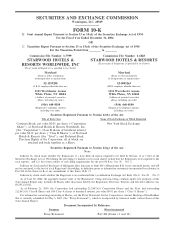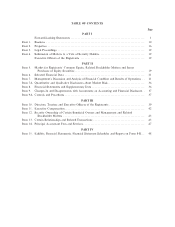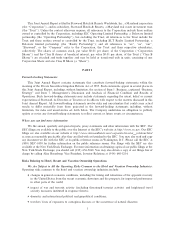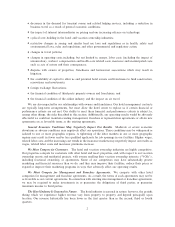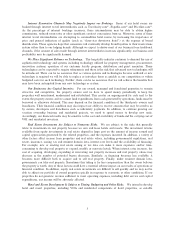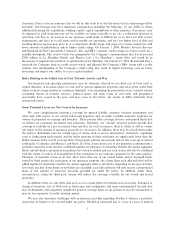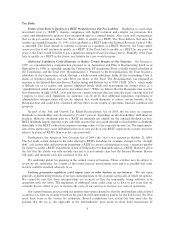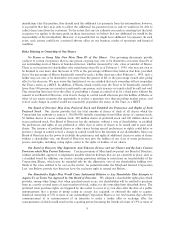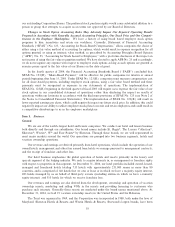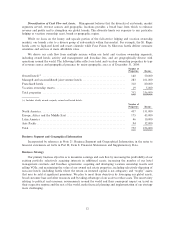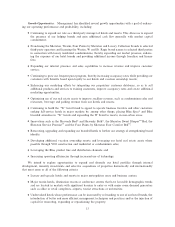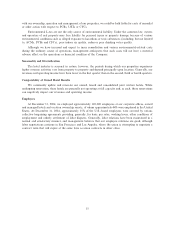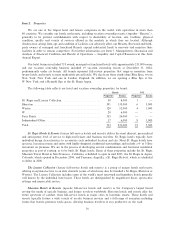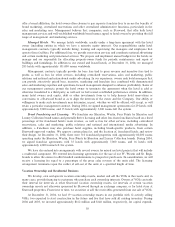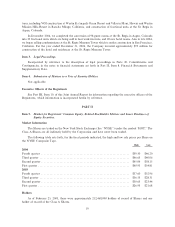Starwood 2004 Annual Report Download - page 17
Download and view the complete annual report
Please find page 17 of the 2004 Starwood annual report below. You can navigate through the pages in the report by either clicking on the pages listed below, or by using the keyword search tool below to find specific information within the annual report.jurisdictions take this position, they should seek the additional tax payments from the intermediary; however,
it is possible that they may seek to collect the additional tax payment from us and we would not be able to
collect these taxes from the customers. To the extent that any tax authority succeeds in asserting that the hotel
occupancy tax applies to the gross proÑt on these transactions, we believe that any additional tax would be the
responsibility of the intermediary. However, it is possible that we might have additional tax exposure. In such
event, such actions could have a material adverse eÅect on our business, results of operations and Ñnancial
condition.
Risks Relating to Ownership of Our Shares
No Person or Group May Own More Than 8% of Our Shares. Our governing documents provide
(subject to certain exceptions) that no one person or group may own or be deemed to own more than 8% of
our outstanding stock or Shares of beneÑcial interest, whether measured by vote, value or number of Shares.
There is an exception for shareholders who owned more than 8% as of February 1, 1995, who may not own or
be deemed to own more than the lesser of 9.9% or the percentage of Shares they held on that date, provided,
that if the percentage of Shares beneÑcially owned by such a holder decreases after February 1, 1995, such a
holder may not own or be deemed to own more than the greater of 8% or the percentage owned after giving
eÅect to the decrease. We may waive this limitation if we are satisÑed that such ownership will not jeopardize
the Trust's status as a REIT. In addition, if Shares which would cause the Trust to be beneÑcially owned by
fewer than 100 persons are issued or transferred to any person, such issuance or transfer shall be null and void.
This ownership limit may have the eÅect of precluding a change in control of us by a third party without the
consent of our Board of Directors, even if such change in control would otherwise give the holders of Shares or
other of our equity securities the opportunity to realize a premium over then-prevailing market prices, and
even if such change in control would not reasonably jeopardize the status of the Trust as a REIT.
Our Board of Directors May Issue Preferred Stock and Establish the Preferences and Rights of Such
Preferred Stock. Our charter provides that the total number of shares of stock of all classes which the
Corporation has authority to issue is 1,350,000,000, initially consisting of one billion shares of common stock,
50 million shares of excess common stock, 200 million shares of preferred stock and 100 million shares of
excess preferred stock. Our Board of Directors has the authority, without a vote of shareholders, to establish
the preferences and rights of any preferred or other class or series of shares to be issued and to issue such
shares. The issuance of preferred shares or other shares having special preferences or rights could delay or
prevent a change in control even if a change in control would be in the interests of our shareholders. Since our
Board of Directors has the power to establish the preferences and rights of additional classes or series of shares
without a shareholder vote, our Board of Directors may give the holders of any class or series preferences,
powers and rights, including voting rights, senior to the rights of holders of our shares.
Our Board of Directors May Implement Anti-Takeover Devices and our Charter and By-Laws Contain
Provisions which May Prevent Takeovers. Certain provisions of Maryland law permit our Board of Directors,
without stockholder approval, to implement possible takeover defenses that are not currently in place, such as
a classiÑed board. In addition, our charter contains provisions relating to restrictions on transferability of the
Corporation Shares, which may be amended only by the aÇrmative vote of our shareholders holding two-
thirds of the votes entitled to be cast on the matter. As permitted under the Maryland General Corporation
Law, our Bylaws provide that directors have the exclusive right to amend our Bylaws.
Our Shareholder Rights Plan Would Cause Substantial Dilution to Any Shareholder That Attempts to
Acquire Us on Terms Not Approved by Our Board of Directors. We adopted a shareholder rights plan which
provides, among other things, that when speciÑed events occur, our shareholders will be entitled to purchase
from us a newly created series of junior preferred stock, subject to the ownership limit described above. The
preferred stock purchase rights are triggered by the earlier to occur of (i) ten days after the date of a public
announcement that a person or group acting in concert has acquired, or obtained the right to acquire,
beneÑcial ownership of 15% or more of our outstanding Corporation Shares or (ii) ten business days after the
commencement of or announcement of an intention to make a tender oÅer or exchange oÅer, the
consummation of which would result in the acquiring person becoming the beneÑcial owner of 15% or more of
9


